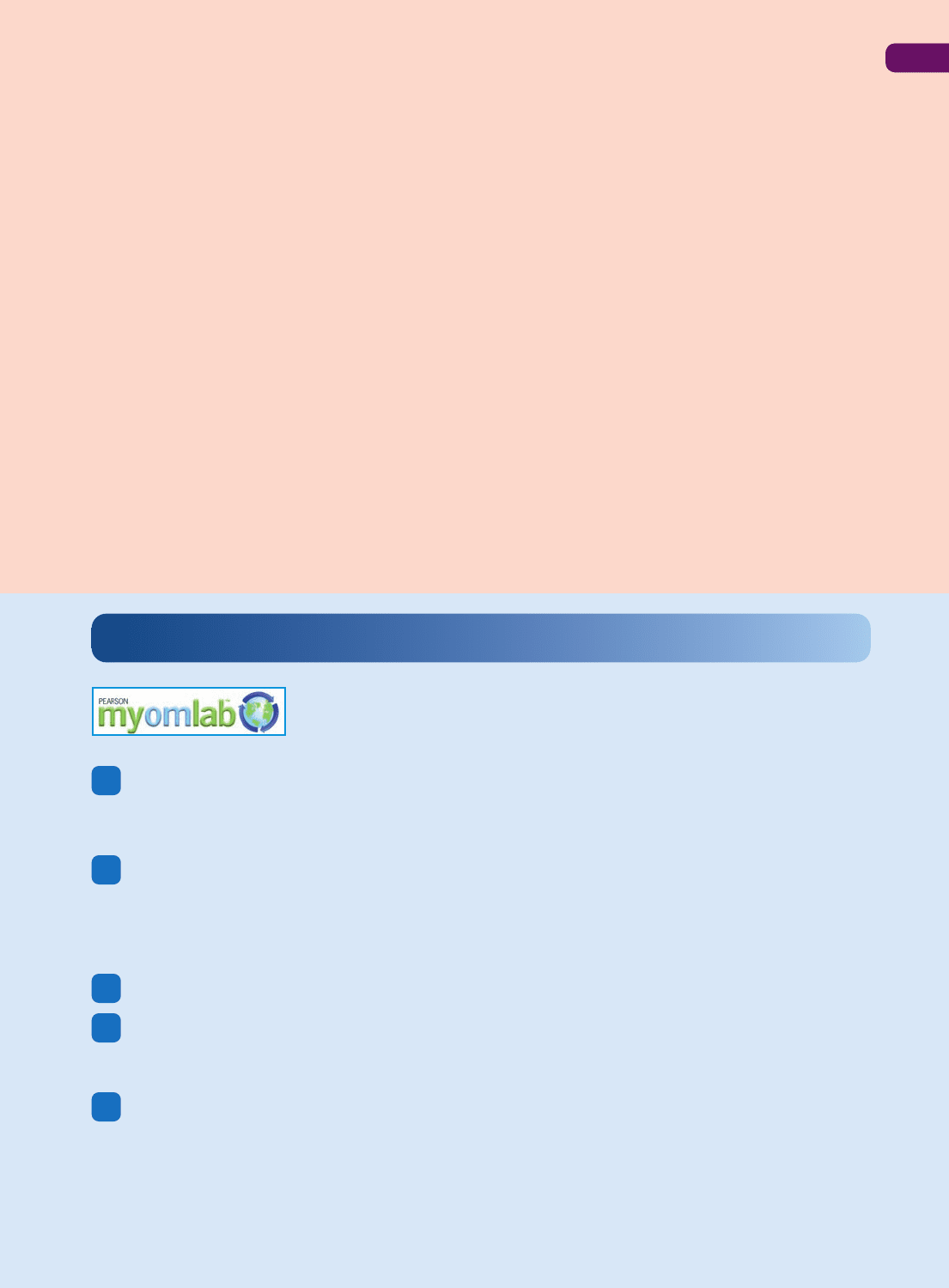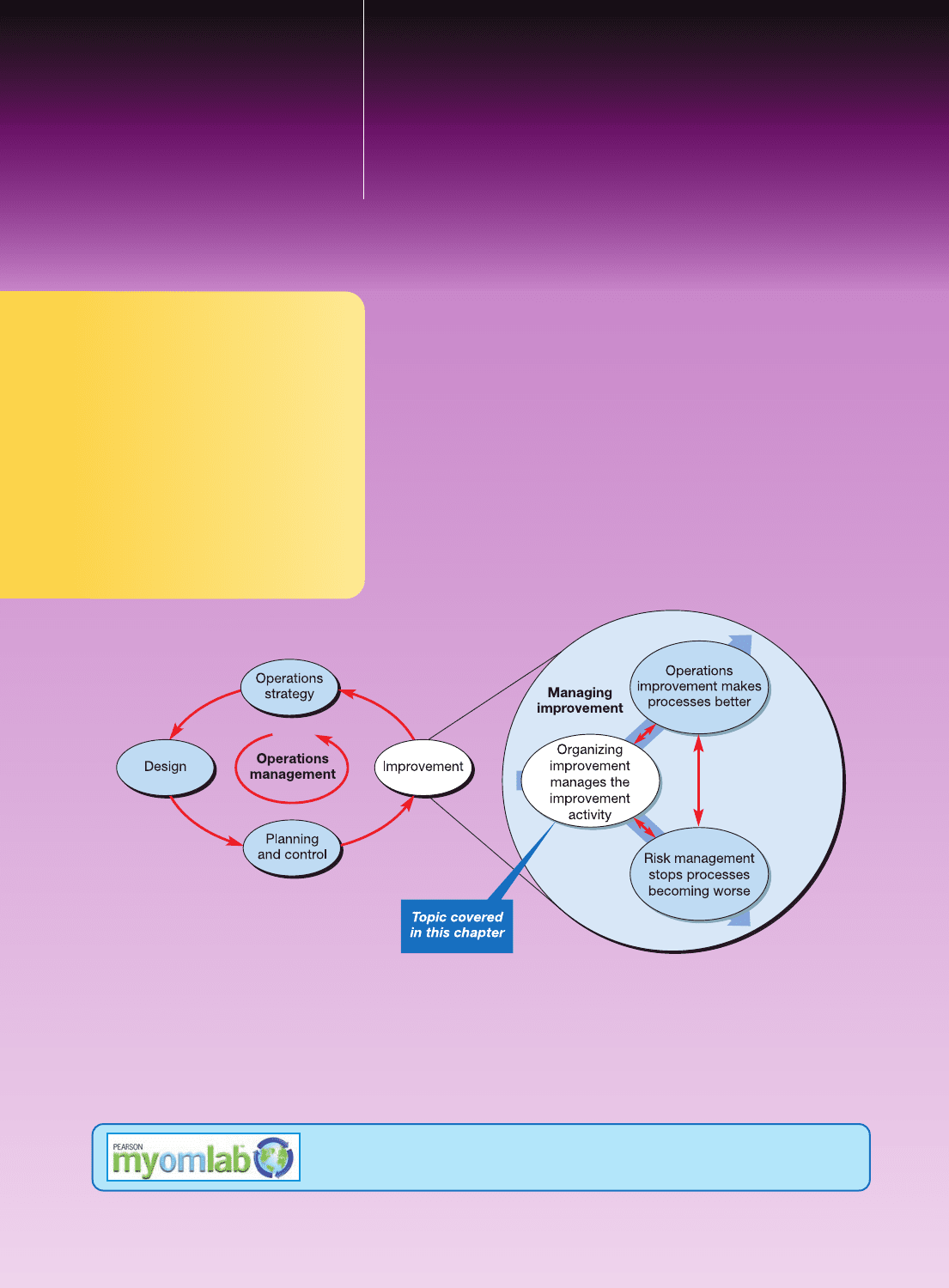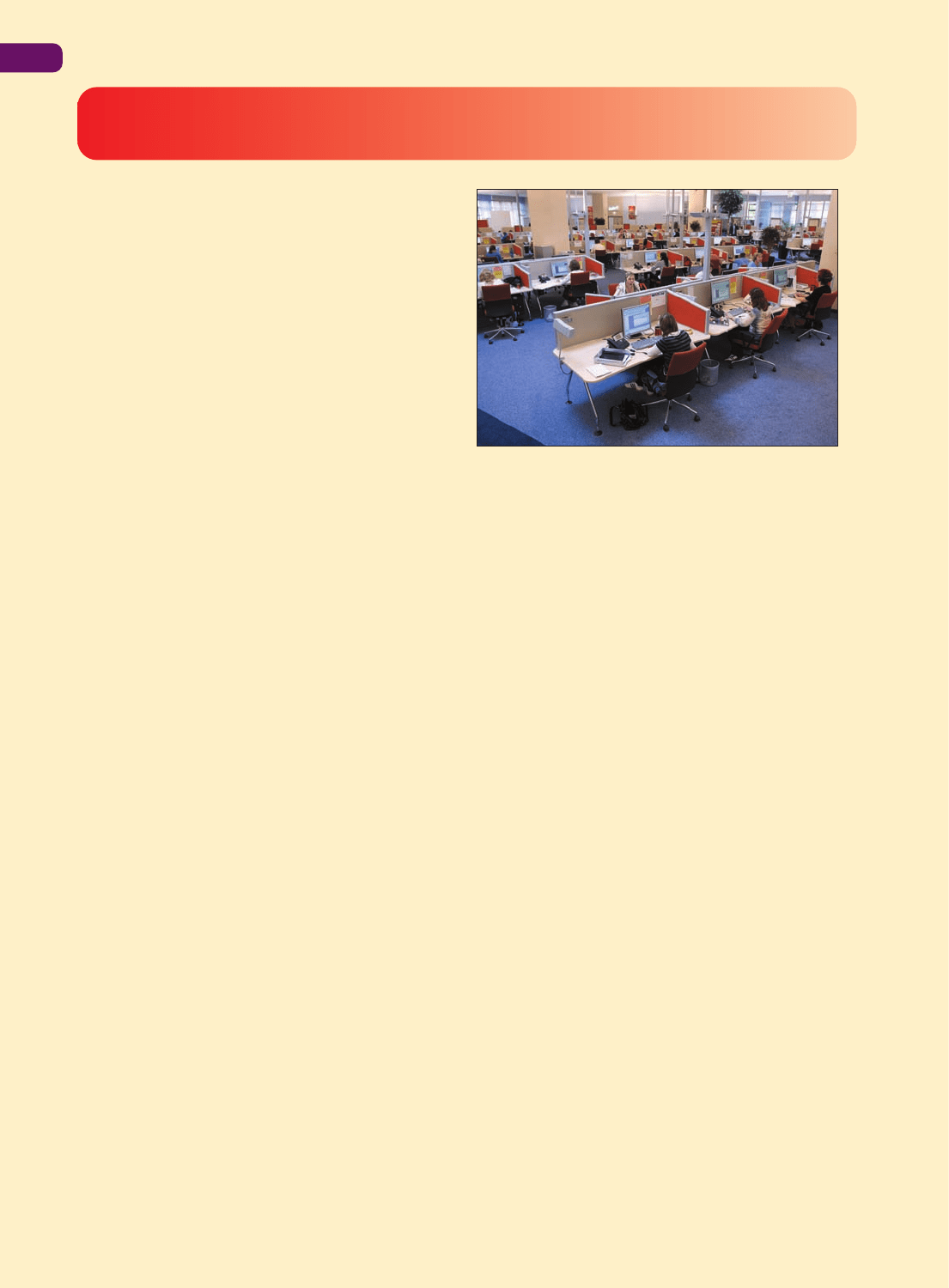Nigel S., Chambers S., Johnson R. Operations Management
Подождите немного. Документ загружается.


been if the operations manager had not worked out what to do. Recovery procedures will
also shape customers’ perceptions of failure. Even where the customer sees a failure, it may
not necessarily lead to dissatisfaction. Indeed, in many situations, customers may well accept
that things do go wrong. If there is a metre of snow on the train lines, or if the restaurant
is particularly popular, we may accept that the product or service does not work. It is not
necessarily the failure itself that leads to dissatisfaction but often the organization’s response
to the breakdown. While mistakes may be inevitable, dissatisfied customers are not. A failure
may even be turned into a positive experience. A good recovery can turn angry, frustrated
customers into loyal ones. One research project used four service scenarios and examined the
willingness of customers to use an organization’s services again.
11
The four scenarios were:
1 The service is delivered to meet the customers’ expectations and there is full satisfaction.
2 There are faults in the service delivery but the customer does not complain about them.
3 There are faults in the service delivery and the customer complains but he/she has been
fobbed off or mollified. There is no real satisfaction with the service provider.
4 There are faults in the service delivery and the customer complains and feels fully satisfied
with the resulting action taken by the service providers.
Customers who are fully satisfied and do not experience any problems (1) are the most
loyal, followed by complaining customers whose complaints are resolved successfully (4).
Customers who experience problems but don’t complain (2) are in third place and last of all
come customers who do complain but are left with their problems unresolved and feelings
of dissatisfaction (3).
Recovery in high-visibility services
The idea of failure recovery has been developed particularly in service operations. As one
specialist put it, ‘If something goes wrong, as it often does, will anybody make special efforts to
get it right? Will somebody go out of his or her way to make amends to the customer? Does anyone
make an effort to offset the negative impact of a screw-up?’
12
It has also been suggested that service
recovery does not just mean ‘return to a normal state’ but to a state of enhanced perception.
All breakdowns require the deliverer to jump through a few hoops to get the customer back to
neutral. More hoops are required for victims to recover. Operations managers need to recognize
that all customers have recovery expectations that they want organizations to meet. Recovery
needs to be a planned process. Organizations therefore need to design appropriate responses
to failure, linked to the cost and the inconvenience caused by the failure to the customer,
which will meet the needs and expectations of the customer. Such recovery processes need to
be carried out either by empowered front-line staff or by trained personnel who are available
to deal with recovery in a way which does not interfere with day-to-day service activities.
Failure planning
Identifying how organizations can recover from failure is of particular interest to service
operations because they can turn failures around to minimize the effect on customers or even
to turn failure into a positive experience. It is also of interest to other industries, however,
especially those where the consequences of failure are particularly severe. Bulk chemical
manufacturers and nuclear processors, for example, spend considerable resources in decid-
ing how they will cope with failures. The activity of devising the procedures which allow the
operation to recover from failure is called failure planning. It is often represented by stage
models, one of which is represented in Figure 19.11. We shall follow it through from the
point where failure is recognized.
Discover. The first thing any manager needs to do when faced with a failure is to discover its
exact nature. Three important pieces of information are needed: first of all, what exactly has
happened; second, who will be affected by the failure; and, third, why did the failure occur?
This last point is not intended to be a detailed inquest into the causes of failure (that comes
Failure planning
Part Four Improvement
594
M19_SLAC0460_06_SE_C19.QXD 10/20/09 9:55 Page 594

Chapter 19 Risk management
595
Business continuity
later) but it is often necessary to know something of the causes of failure in case it is neces-
sary to determine what action to take.
Act. The discover stage could only take minutes or even seconds, depending on the severity
of the failure. If the failure is a severe one with important consequences, we need to move on
to doing something about it quickly. This means carrying out three actions, the first two of
which could be carried out in reverse order, depending on the urgency of the situation. First,
tell the significant people involved what you are proposing to do about the failure. In service
operations this is especially important where the customers need to be kept informed, both
for their peace of mind and to demonstrate that something is being done. In all operations,
however, it is important to communicate what action is going to happen so that everyone can
set their own recovery plans in motion. Second, the effects of the failure need to be contained
in order to stop the consequences spreading and causing further failures. The precise con-
tainment actions will depend on the nature of the failure. Third, there needs to be some kind
of follow-up to make sure that the containment actions really have contained the failure.
Learn. As discussed earlier in this chapter, the benefits of failure in providing learning oppor-
tunities should not be underestimated. In failure planning, learning involves revisiting the
failure to find out its root cause and then engineering out the causes of the failure so that it
will not happen again. This is the key stage for much failure planning.
Plan. Learning the lessons from a failure is not the end of the procedure. Operations
managers need formally to incorporate the lessons into their future reactions to failures. This
is often done by working through ‘in theory’ how they would react to failures in the future.
Specifically, this involves first identifying all the possible failures which might occur (in a
similar way to the FMEA approach). Second, it means formally defining the procedures
which the organization should follow in the case of each type of identified failure.
Business continuity
Many of the ideas behind failure, failure prevention and recovery are incorporated in the
growing field of business continuity. This aims to help operations avoid and recover from
disasters while keeping the business going, an issue that has risen to near the top of many
firms’ agenda since 11 September 2001. As operations become increasingly integrated (and
increasingly dependent on integrated technologies such as information technologies), critical
failures can result from a series of related and unrelated events and combine to disrupt totally
a company’s business. These events are the critical malfunctions which have the potential to
interrupt normal business activity and even stop the entire company, such as natural disasters,
fire, power or telecommunications failure, corporate crime, theft, fraud, sabotage, computer
system failure, bomb blast, scare or other security alert, key personnel leaving, becoming ill
or dying, key suppliers ceasing trading, contamination of product or processes, and so on.
Figure 19.11 The stages in failure planning
M19_SLAC0460_06_SE_C19.QXD 10/20/09 9:55 Page 595

Summary answers to key questions
Check and improve your understanding of this chapter using self assessment questions
and a personalised study plan, audio and video downloads, and an eBook – all at
www.myomlab.com.
➤ What is risk management?
■ Risk management is about things going wrong and what operations can do to stop things
going wrong. Or, more formally, ‘the process which aims to help organizations understand,
evaluate and take action on all their risks with a view to increasing the probability of their
success and reducing the likelihood of failure’.
■ It consists of four broad activities:
– Understanding what failures could occur.
– Preventing failures occurring.
– Minimizing the negative consequences of failure (called risk ‘mitigation’).
– Recovering from failures when they do occur.
➤ How can operations assess the potential causes of, and risks from failure?
■ There are several causes of operations failure including design failures, facilities failure, staff
failure, supplier failure, customer failure and environmental disruption.
■ There are three ways of measuring failure. ‘Failure rates’ indicate how often a failure is likely to
occur. ‘Reliability’ measures the chances of a failure occurring. ‘Availability’ is the amount of
available and useful operating time left after taking account of failures.
The procedures adopted by business continuity experts are very similar to those described in
this chapter:
● Identify and assess risks to determine how vulnerable the business is to various risks and to
take steps to minimize or eliminate them.
● Identify core business processes to prioritize those that are particularly important to the
business and which, if interrupted, would have to be brought back to full operation
quickly.
● Quantify recovery times to make sure staff understand priorities (for example, get customer
ordering system back into operation before the internal e-mail).
● Determine resources needed to make sure that resources will be available when required.
● Communicate to make sure that everyone in the operation knows what to do if disaster
strikes.
One response to the threat of such large-scale failures has been a rise in the number of
companies offering ‘replacement office’ operations. These are fully equipped offices, often
with access to a company’s current management information and with normal Internet and
telephone communications links. They are fully working offices but with no people. Should
a customer’s main operation be affected by a disaster, business can continue in the replace-
ment facility within days or even hours. The provision of this type of replacement office is,
in effect, a variation of the ‘redundancy’ approach to reducing the impact of failure that was
discussed earlier in this chapter.
Part Four Improvement
596
M19_SLAC0460_06_SE_C19.QXD 10/20/09 9:55 Page 596

■ Failure over time is often represented as a failure curve. The most common form of this is the
so-called ‘bath-tub curve’ which shows the chances of failure being greater at the beginning
and end of the life of a system or part of a system.
■ Failure analysis mechanisms include accident investigation, product liability, complaint analysis,
critical incident analysis, and failure mode and effect analysis (FMEA).
➤ How can failures be prevented?
■ There are four major methods of improving reliability: designing out the fail points in the operation,
building redundancy into the operation, ‘fail-safeing’ some of the activities of the operation,
and maintenance of the physical facilities in the operation.
■ Maintenance is the most common way operations attempt to improve their reliability, with three
broad approaches. The first is running all facilities until they break down and then repairing
them, the second is regularly maintaining the facilities even if they have not broken down, and
the third is to monitor facilities closely to try to predict when breakdown might occur.
■ Two specific approaches to maintenance have been particularly influential: total productive
maintenance (TPM) and reliability-centred maintenance (RCM).
➤ How can operations mitigate the effects of failure?
■ Risk, or failure, mitigation means isolating a failure from its negative consequences.
■ Risk mitigation actions include:
– Mitigation planning.
– Economic mitigation.
– Containment (spatial and temporal).
– Loss reduction.
– Substitution.
➤ How can operations recover from the effects of failure?
■ Recovery can be enhanced by a systematic approach to discovering what has happened to
cause failure, acting to inform, contain and follow up the consequences of failure, learning to
find the root cause of the failure and preventing it taking place again, and planning to avoid the
failure occurring in the future.
■ The idea of ‘business continuity’ planning is a common form of recovery planning.
Chapter 19 Risk management
597
At 1.24 in the early hours of Saturday morning on 26 April
1986, the worst accident in the history of commercial nuclear
power generation occurred. Two explosions in quick
succession blew off the 1,000-tonne concrete sealing
cap of the Chernobyl-4 nuclear reactor. Molten core frag-
ments showered down on the immediate area and fission
Case study
The Chernobyl failure
13
products were released into the atmosphere. The accident
cost probably hundreds of lives and contaminated vast
areas of land in Ukraine.
Many reasons probably contributed to the disaster.
Certainly the design of the reactor was not new – around
30 years old at the time of the accident – and had been
M19_SLAC0460_06_SE_C19.QXD 10/20/09 9:55 Page 597

conceived before the days of sophisticated computer-
controlled safety systems. Because of this, the reactor’s
emergency-handling procedures relied heavily on the skill
of the operators. This type of reactor also had a tendency
to run ‘out of control’ when operated at low power. For this
reason, the operating procedures for the reactor strictly pro-
hibited it being operated below 20 per cent of its maximum
power. It was mainly a combination of circumstance and
human error which caused the failure, however. Ironically,
the events which led up to the disaster were designed to
make the reactor safer. Tests, devised by a specialist team
of engineers, were being carried out to evaluate whether the
emergency core cooling system (ECCS) could be operated
during the ‘free-wheeling’ run-down of the turbine genera-
tor, should an off-site power failure occur. Although this
safety device had been tested before, it had not worked
satisfactorily and new tests of the modified device were to
be carried out with the reactor operating at reduced power
throughout the test period. The tests were scheduled for
the afternoon of Friday, 25 April 1986 and the plant power
reduction began at 1.00 pm. However, just after 2.00 pm,
when the reactor was operating at about half its full power,
the Kiev controller requested that the reactor should con-
tinue supplying the grid with electricity. In fact it was not
released from the grid until 11.10 that night. The reactor
was due to be shut down for its annual maintenance on
the following Tuesday and the Kiev controller’s request
had in effect shrunk the ‘window of opportunity’ available
for the tests.
The following is a chronological account of the hours up
to the disaster, together with an analysis by James Reason,
which was published in the Bulletin of the British Psycho-
logical Society the following year. Significant operator actions
are italicized. These are of two kinds: errors (indicated by
an ‘E’) and procedural violations (marked with a ‘V’).
25 April 1986
1.00 pm Power reduction started with the intention of
achieving 25 per cent power for test conditions.
2.00 pm ECCS disconnected from primary circuit. (This
was part of the test plan.)
2.05 pm Kiev controller asked the unit to continue supplying
grid. The ECCS was not reconnected (V). (This particular
violation is not thought to have contributed materially to the
disaster, but it is indicative of a lax attitude on the part of
the operators toward the observance of safety procedures.)
11.10 pm The unit was released from the grid and contin-
ued power reduction to achieve the 25 per cent power
level planned for the test programme.
26 April 1986
12.28 am Operator seriously undershot the intended power
setting (E). The power dipped to a dangerous one per cent.
(The operator had switched off the ‘auto-pilot’ and had
tried to achieve the desired level by manual control.)
1.00 am After a long struggle, the reactor power was
finally stabilized at 7 per cent – well below the intended
level and well into the low-power danger zone. At this point,
the experiment should have been abandoned, but it was
not (E). This was the most serious mistake (as opposed to
violation): it meant that all subsequent activity would be
conducted within the reactor’s zone of maximum instability.
This was apparently not appreciated by the operators.
1.03 am All eight pumps were started (V ). The safety reg-
ulations limited the maximum number of pumps in use at
any one time to six. This showed a profound misunder-
standing of the physics of the reactor. The consequence
was that the increased water flow (and reduced steam
fraction) absorbed more neutrons, causing more control
rods to be withdrawn to sustain even this low level of power.
1.19 am The feedwater flow was increased threefold (V ).
The operators appear to have been attempting to cope with
a falling steam-drum pressure and water level. The result
of their actions, however, was to further reduce the amount
of steam passing through the core, causing yet more con-
trol rods to be withdrawn. They also overrode the steam-
drum automatic shut-down (V). The effect of this was to
strip the reactor of one of its automatic safety systems.
1.22 am The shift supervisor requested printout to estab-
lish how many control rods were actually in the core. The
printout indicated only six to eight rods remaining. It was
strictly forbidden to operate the reactor with fewer than
twelve rods. Yet the shift supervisor decided to continue
with the tests (V). This was a fatal decision: the reactor was
thereafter without ‘brakes’.
1.23 am The steam line valves to No 8 turbine generator
were closed (V). The purpose of this was to establish the
conditions necessary for repeated testing, but its conse-
quence was to disconnect the automatic safety trips. This
was perhaps the most serious violation of all.
1.24 am An attempt was made to ‘scram’ the reactor by
driving in the emergency shut-off rods, but they jammed
within the now-warped tubes.
Part Four Improvement
598
Source: © Vladimir Repik/Reuters/Corbis
M19_SLAC0460_06_SE_C19.QXD 10/20/09 9:55 Page 598

1.24 am Two explosions occurred in quick succession.
The reactor roof was blown off and 30 fires started in the
vicinity.
1.30 am Duty firemen were called out. Other units were
summoned from Pripyat and Chernobyl.
5.00 am Exterior fires had been extinguished, but the
graphite fire in the core continued for several days.
The subsequent investigation into the disaster highlighted
a number of significant points which contributed to it:
● The test programme was poorly worked out and the
section on safety measures was inadequate. Because
the ECCS was shut off during the test period, the safety
of the reactor was in effect substantially reduced.
● The test plan was put into effect before being approved
by the design group who were responsible for the
reactor.
● The operators and the technicians who were running
the experiment had different and non-overlapping skills.
● The operators, although highly skilled, had probably been
told that getting the test completed before the shut-down
would enhance their reputation. They were proud of their
ability to handle the reactor even in unusual conditions
and were aware of the rapidly reducing window of
opportunity within which they had to complete the test.
They had also probably ‘lost any feeling for the hazards
involved’ in operating the reactor.
● The technicians who had designed the test were elec-
trical engineers from Moscow. Their objective was to
solve a complex technical problem. In spite of having
designed the test procedures, they probably would not
know much about the operation of the nuclear power
station itself.
Again, in the words of James Reason: ‘Together, they
made a dangerous mixture: a group of single-minded but
non-nuclear engineers directing a team of dedicated but
over-confident operators. Each group probably assumed
that the other knew what it was doing. And both parties
had little or no understanding of the dangers they were
courting, or of the system they were abusing.’
Questions
1 What were the root causes which contributed to the
ultimate failure?
2 How could failure planning have helped prevent the
disaster?
Chapter 19 Risk management
599
These problems and applications will help to improve your analysis of operations. You
can find more practice problems as well as worked examples and guided solutions on
MyOMLab at
www.myomlab.com.
‘We have a test bank where we test batches of 100 of our products continuously for 7 days and nights.
This week only 3 failed, the first after 10 hours, the second after 72 hours, and the third after 1,020 hours.’
What is the failure rate in percentage terms and in time terms for this product?
An automatic testing process takes samples of ore from mining companies and subjects them to four sequential
tests. The reliability of the four different test machines that perform the tasks is different. The first test machine
has a reliability of 0.99, the second has a reliability of 0.92, the third has a reliability of 0.98, and the fourth a
reliability of 0.95. If one of the machines stops working, the total process will stop. What is the reliability of the
total process?
For the product testing example in Problem 1, what is the mean time between failures (MTBF) for the products?
Conduct a survey amongst colleagues, friends and acquaintances of how they cope with the possibility that
their computers might ‘fail’, either in terms of ceasing to operate effectively, or in losing data. Discuss how the
concept of redundancy applies in such failure.
In terms of its effectiveness at managing the learning process, how does a university detect failures? What could
it do to improve its failure detection processes?
5
4
3
2
1
Problems and applications
M19_SLAC0460_06_SE_C19.QXD 10/20/09 9:55 Page 599

Part Four Improvement
600
Dhillon, B.S. (2002) Engineering Maintenance: A Modern
Approach, CRC Press, Boca Raton, Fla. A comprehensive
book for the enthusiastic that stresses the ‘cradle-to-grave’
aspects of maintenance.
Li, Jun
||
Yu, Kui-Long
||
Wang, Liang-Xi
||
Song, Hai-Jun
Zhuangjiabing Gongcheng Xueyuan Xuebao (2007)
Research on operational risk management for equipment,
Journal of Academy of Armored Force Engineering, vol. 21,
no. 2, 8–11. Not as dull as it sounds. Deals with risks
in military operations including complex equipment
systems.
Regester, M. and Larkin, J. (2005) Risk Issues and Crisis Man-
agement: A Casebook of Best Practice, Kogan Page. Aimed at
practising managers with lots of advice. Good for getting
the flavour of how it is in practice.
Smith, D.J. (2000) Reliability, Maintainability and Risk,
Butterworth-Heinemann. A comprehensive and excellent
guide to all aspects of maintenance and reliability.
Selected further reading
www.smrp.org/ Site of the Society for Maintenance and Reliabil-
ity Professionals. Gives an insight into practical issues.
www.sre.org/ American Society of Reliability Engineers. The
newsletters give insights into reliability practice.
http://csob.berry.edu/faculty/jgrout/pokayoke.shtml The
poka-yoke page of John Grout. Some great examples,
tutorials, etc.
www.rspa.com/spi/SQA.html Lots of resources, involving
reliability and poka-yoke.
http://sra.org/ Site of the Society for Risk Analysis. Very wide
scope, but interesting.
www.hse.gov.uk/risk Health and Safety Executive of the UK
government.
www.theirm.org The home page of the Institute of Risk
Management.
www.opsman.org Lots of useful stuff.
Useful web sites
Now that you have finished reading this chapter, why not visit MyOMLab at
www.myomlab.com where you’ll find more learning resources to help you
make the most of your studies and get a better grade?
M19_SLAC0460_06_SE_C19.QXD 10/20/09 9:55 Page 600

Introduction
This is the third, and final, chapter devoted to operations
improvement. It examines some of the managerial issues
associated with improvement can be organized. There are
no techniques as such in this chapter. Nor are all the issues
dealt with easily defined. Rather it covers the ‘soft’ side of
improvement. But do not dismiss this as in any way less
important. In practice it is often the ‘soft’ stuff that determines
the success or failure of improvement efforts. Moreover, the
‘soft’ stuff can be more difficult to get right than the ‘hard’, more
technique-based, aspects of improvement. The ‘hard’ stuff is
hard, but the ‘soft’ stuff is harder!
Chapter 20
Organizing for
improvement
Key questions
➤ Why does improvement need
organizing?
➤ How should the improvement effort
be linked to strategy?
➤ What information is needed for
improvement?
➤ What should be improvement
priorities?
➤ How can organizational culture
affect improvement?
➤ What are the key implementation
issues?
Figure 20.1 This chapter covers organizing of improvement
Check and improve your understanding of this chapter using self assessment
questions and a personalised study plan, audio and video downloads, and an
eBook – all at www.myomlab.com.
M20_SLAC0460_06_SE_C20.QXD 10/20/09 9:56 Page 601

Operations effectiveness is just as important an issue
in public-sector operations as it is for commercial
companies. People have the right to expect that their
taxes are not wasted on inefficient or inappropriate public
processes. This is especially true of the tax collecting
system itself. It is never a popular organization in any
country, and taxpayers can be especially critical when
the tax collection process is not well managed. This was
very much on the minds of the Aarhus Region Customs
and Tax unit (Aarhus CT) when they developed their
award-winning quality initiative. The Aarhus Region is the
largest of Denmark’s twenty-nine local customs and tax
offices. It acts as an agent for central government in
collecting taxes in a professional and efficient manner
while being able to respond to taxpayers’ queries.
Aarhus CT must, ‘keep the user (customer) in focus’,
they say, ‘Users must pay what is due – no more, no
less and on time. But users are entitled to fair control
and collection, fast and efficient case work, service and
guidance, flexible employees, polite behaviour and a
professional telephone service.’ The Aarhus CT approach
to managing its quality initiative was built around a
number of key points.
● A recognition that poor-quality processes cause waste
both internally and externally.
● A determination to adopt a practice of regularly
surveying the satisfaction of its users. Employees were
also surveyed, both to understand their views on
quality and to check that their working environment
would help to instil the principles of high-quality
service.
● Although a not-for-profit organization, quality
measures included measuring the organization’s
adherence to financial targets as well as error
reporting.
● Internal processes were redefined and redesigned
to emphasize customer needs and internal staff
requirements. For example, Aarhus CT was the only
tax region in Denmark to develop an independent
information process that was used to analyse
customers’ needs and ‘prevent misunderstanding in
users’ perception of legislation’.
● Internal processes were designed to allow staff the
time and opportunity to develop their own skills,
exchange ideas with colleagues and take on greater
responsibility for management of their own work
processes.
● The organization set up what it called its ‘Quality
Organization’ (QO) structure which spanned all
divisions and processes. The idea of the QO was to
foster staff commitment to continuous improvement
and to encourage the development of ideas for
improving process performance. Within the QO
was the Quality Group (QG). This consisted of four
managers and four process staff, and reported
directly to senior management. It also set up a
number of improvement groups and suggestion
groups consisting of managers as well as process
staff. The role of the suggestion groups was to
collect and process ideas for improvement which
the improvement groups would then analyse and if
appropriate implement.
● Aarhus CT was keen to stress that their Quality
Groups would eventually become redundant if they
were to be successful. In the short term they would
maintain a stream of improvement ideas, but in the
long term they should have fully integrated the idea
of quality improvement into the day-to-day activities
of all staff.
Operations in practice Taxing quality
1
Part Four Improvement
602
Source: Rex Features
M20_SLAC0460_06_SE_C20.QXD 10/20/09 9:56 Page 602

Chapter 20 Organizing for improvement
603
Why the improvement effort needs organizing
Improvement does not just happen. It needs organizing and it needs implementing. It
also needs a purpose that is well thought through and clearly articulated. Although much
operations improvement will take place at an operational level, and especially if one is
following a continuous improvement philosophy (see previous chapter), it will be small-scale
and incremental. Nevertheless, it must be placed in some kind of context. That is, it should
be clear why improvement is happening as well as what it consists of. This means linking the
improvement to the overall strategic objectives of the organization. This is why we start this
chapter by thinking about improvement in a strategic context. Improvement must also be
based on sound information. If the performance of operations and the processes within them
are to be improved, one must first be able to define and measure exactly what we mean by
‘performance’. Furthermore, benchmarking one’s own activities and performance against
other organizations’ activities and performance can lead to valuable insights and help to
quantify progress. It also helps to answer some basic improvement questions such as
who should be in charge of it, when should it take place, and how one should go about
ensuring that improvement really does impact the performance of the organization. This is
why in this chapter we will deal with such issues as measuring performance, benchmarking,
prioritization, learning and culture, and the role of systems of procedures in the imple-
mentation process.
Remember also that the issue of how improvement should be organized is not a new con-
cern. It has been a concern of management writers for decades. For example, W.E. Deming
(considered in Japan to be the father of quality control) asserted that quality starts with top
management and is a strategic activity.
2
It is claimed that much of the success in terms of
quality in Japanese industry was the result of his lectures to Japanese companies in the 1950s.
3
Deming’s basic philosophy is that quality and productivity increase as ‘process variability’
(the unpredictability of the process) decreases. In his 14 points for quality improvement, he
emphasizes the need for statistical control methods, participation, education, openness and
purposeful improvement:
1 Create constancy of purpose.
2 Adopt new philosophy.
3 Cease dependence on inspection.
4 End awarding business on price.
5 Improve constantly the system of production and service.
6 Institute training on the job.
7 Institute leadership.
8 Drive out fear.
9 Break down barriers between departments.
10 Eliminate slogans and exhortations.
11 Eliminate quotas or work standards.
12 Give people pride in their job.
13 Institute education and a self-improvement programme.
14 Put everyone to work to accomplish it.
Linking improvement to strategy
At one level, the objective of any improvement is obvious – it tries to make things better!
But, does this mean better in every way or better in some specific manner? And how much
better does better mean? This is why we need some more general framework to put any
M20_SLAC0460_06_SE_C20.QXD 10/20/09 9:56 Page 603
